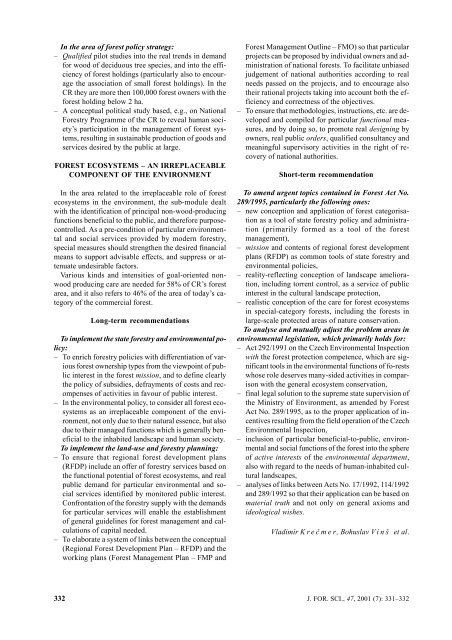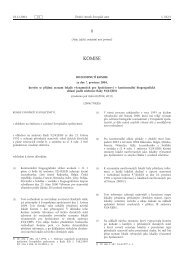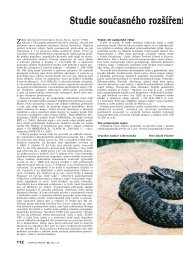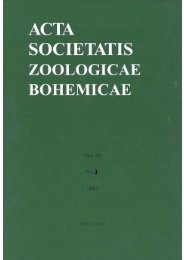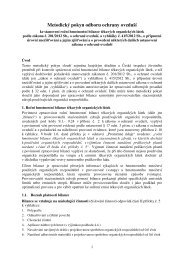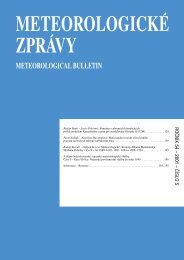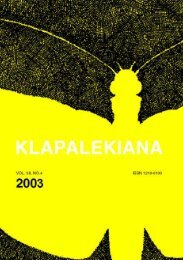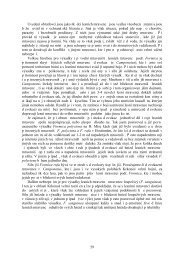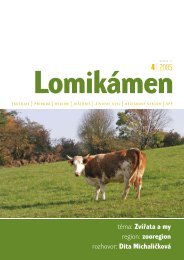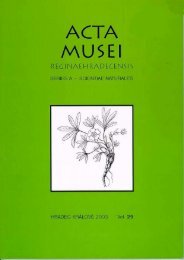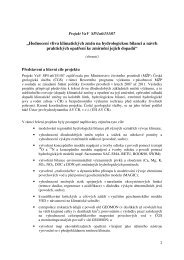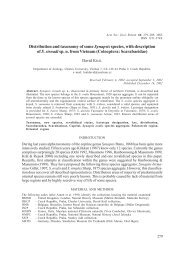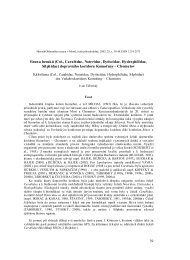journal of forest science
journal of forest science
journal of forest science
You also want an ePaper? Increase the reach of your titles
YUMPU automatically turns print PDFs into web optimized ePapers that Google loves.
In the area <strong>of</strong> <strong>forest</strong> policy strategy:<br />
– Qualified pilot studies into the real trends in demand<br />
for wood <strong>of</strong> deciduous tree species, and into the efficiency<br />
<strong>of</strong> <strong>forest</strong> holdings (particularly also to encourage<br />
the association <strong>of</strong> small <strong>forest</strong> holdings). In the<br />
CR they are more then 100,000 <strong>forest</strong> owners with the<br />
<strong>forest</strong> holding below 2 ha.<br />
– A conceptual political study based, e.g., on National<br />
orestry Programme <strong>of</strong> the CR to reveal human society’s<br />
participation in the management <strong>of</strong> <strong>forest</strong> systems,<br />
resulting in sustainable production <strong>of</strong> goods and<br />
services desired by the public at large.<br />
OREST ECOSYSTEMS – AN IRREPLACEABLE<br />
COMPONENT O THE ENVIRONMENT<br />
In the area related to the irreplaceable role <strong>of</strong> <strong>forest</strong><br />
ecosystems in the environment, the sub-module dealt<br />
with the identification <strong>of</strong> principal non-wood-producing<br />
functions beneficial to the public, and therefore purposecontrolled.<br />
As a pre-condition <strong>of</strong> particular environmental<br />
and social services provided by modern <strong>forest</strong>ry,<br />
special measures should strengthen the desired financial<br />
means to support advisable effects, and suppress or attenuate<br />
undesirable factors.<br />
Various kinds and intensities <strong>of</strong> goal-oriented nonwood<br />
producing care are needed for 58% <strong>of</strong> CR’s <strong>forest</strong><br />
area, and it also refers to 46% <strong>of</strong> the area <strong>of</strong> today’s category<br />
<strong>of</strong> the commercial <strong>forest</strong>.<br />
Long-term recommendations<br />
To implement the state <strong>forest</strong>ry and environmental policy:<br />
– To enrich <strong>forest</strong>ry policies with differentiation <strong>of</strong> various<br />
<strong>forest</strong> ownership types from the viewpoint <strong>of</strong> public<br />
interest in the <strong>forest</strong> mission, and to define clearly<br />
the policy <strong>of</strong> subsidies, defrayments <strong>of</strong> costs and recompenses<br />
<strong>of</strong> activities in favour <strong>of</strong> public interest.<br />
– In the environmental policy, to consider all <strong>forest</strong> ecosystems<br />
as an irreplaceable component <strong>of</strong> the environment,<br />
not only due to their natural essence, but also<br />
due to their managed functions which is generally beneficial<br />
to the inhabited landscape and human society.<br />
To implement the land-use and <strong>forest</strong>ry planning:<br />
– To ensure that regional <strong>forest</strong> development plans<br />
(RDP) include an <strong>of</strong>fer <strong>of</strong> <strong>forest</strong>ry services based on<br />
the functional potential <strong>of</strong> <strong>forest</strong> ecosystems, and real<br />
public demand for particular environmental and social<br />
services identified by monitored public interest.<br />
Confrontation <strong>of</strong> the <strong>forest</strong>ry supply with the demands<br />
for particular services will enable the establishment<br />
<strong>of</strong> general guidelines for <strong>forest</strong> management and calculations<br />
<strong>of</strong> capital needed.<br />
– To elaborate a system <strong>of</strong> links between the conceptual<br />
(Regional orest Development Plan – RDP) and the<br />
working plans (orest Management Plan – MP and<br />
orest Management Outline – MO) so that particular<br />
projects can be proposed by individual owners and administration<br />
<strong>of</strong> national <strong>forest</strong>s. To facilitate unbiased<br />
judgement <strong>of</strong> national authorities according to real<br />
needs passed on the projects, and to encourage also<br />
their rational projects taking into account both the efficiency<br />
and correctness <strong>of</strong> the objectives.<br />
– To ensure that methodologies, instructions, etc. are developed<br />
and compiled for particular functional measures,<br />
and by doing so, to promote real designing by<br />
owners, real public orders, qualified consultancy and<br />
meaningful supervisory activities in the right <strong>of</strong> recovery<br />
<strong>of</strong> national authorities.<br />
Short-term recommendation<br />
To amend urgent topics contained in orest Act No.<br />
289/1995, particularly the following ones:<br />
– new conception and application <strong>of</strong> <strong>forest</strong> categorisation<br />
as a tool <strong>of</strong> state <strong>forest</strong>ry policy and administration<br />
(primarily formed as a tool <strong>of</strong> the <strong>forest</strong><br />
management),<br />
– mission and contents <strong>of</strong> regional <strong>forest</strong> development<br />
plans (RDP) as common tools <strong>of</strong> state <strong>forest</strong>ry and<br />
environmental policies,<br />
– reality-reflecting conception <strong>of</strong> landscape amelioration,<br />
including torrent control, as a service <strong>of</strong> public<br />
interest in the cultural landscape protection,<br />
– realistic conception <strong>of</strong> the care for <strong>forest</strong> ecosystems<br />
in special-category <strong>forest</strong>s, including the <strong>forest</strong>s in<br />
large-scale protected areas <strong>of</strong> nature conservation.<br />
To analyse and mutually adjust the problem areas in<br />
environmental legislation, which primarily holds for:<br />
– Act 292/1991 on the Czech Environmental Inspection<br />
with the <strong>forest</strong> protection competence, which are significant<br />
tools in the environmental functions <strong>of</strong> fo-rests<br />
whose role deserves many-sided activities in comparison<br />
with the general ecosystem conservation,<br />
– final legal solution to the supreme state supervision <strong>of</strong><br />
the Ministry <strong>of</strong> Environment, as amended by orest<br />
Act No. 289/1995, as to the proper application <strong>of</strong> incentives<br />
resulting from the field operation <strong>of</strong> the Czech<br />
Environmental Inspection,<br />
– inclusion <strong>of</strong> particular beneficial-to-public, environmental<br />
and social functions <strong>of</strong> the <strong>forest</strong> into the sphere<br />
<strong>of</strong> active interests <strong>of</strong> the environmental department,<br />
also with regard to the needs <strong>of</strong> human-inhabited cultural<br />
landscapes,<br />
– analyses <strong>of</strong> links between Acts No. 17/1992, 114/1992<br />
and 289/1992 so that their application can be based on<br />
material truth and not only on general axioms and<br />
ideological wishes.<br />
Vladimír K r e è m e r, Bohuslav V i n š et al.<br />
332 J. FOR. SCI., 47, 2001 (7): 331–332


